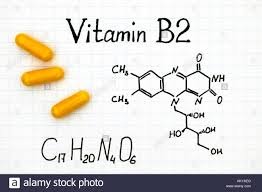
Definition
Vitamin B2 was first isolated from milk in 1933. It is made up of a nitrogen-containing ring structure.
Riboflavin has a yellowish green light, easily dissolved in water and can withstand heat well. Most of riboflavins are found in the red blood cells. The excretion occurs through the urine.
The unit of measurement for Vitamin B2 is milligram (mg).
Permitted Daily Dosage
In Norway, the maximum daily dose for Vitamin B2 is 2.8mg. The recommended daily dose is 1.7mg.
Vitamin B2 is mostly found in milk, cheese, beers, liver, fish, eggs, flour, broccoli, spinach, beans, nuts and avocado.
Function
Riboflavin is very important for the oxygen to be converted into energy, as it is included in certain co enzymes. It is also important for the metabolism of carbohydrates, proteins and fats.
In addition, Vitamin B2 is important in the production of a number of important substances, such as fatty acids, norepinephrine, niacin, serotonin, histamine and acetylcholine.
It also acts as an antioxidant and is important for skin, hair and eyes.
Practical Use
To prevent deficiencies, you can use 5mg Vitamin B2 per day.
Deficiency symptoms may occur as cracks in the mouths, crazy fingernails, hair loss and itching in the eyes. Chronically ill, elderly people and people who are taking medication may have too little Vitamin B2 in their body and therefore need to take a supplement.
Furthermore, it will be beneficial for pregnant, breastfeeding and top athletes.
In the wounds of the mouth , dry skin and dry hair, you can take 20-25mg for a few weeks.
It is important to take Vitamin B2 together with the other B vitamins.
No adverse effects have been observed in doses up to 1000mg.